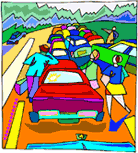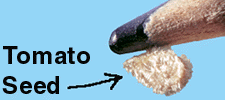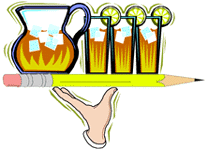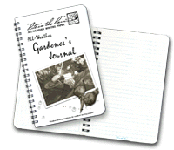
A Pencil Is a Gardener's Best
Friend
From seed-sowing tool to swizzle stick!
By Marion Owen, Fearless Weeder
for PlanTea, Inc. and
Co-author of Chicken Soup for the Gardener's Soul
FEATURE ARTICLE:

Tom Hanks' "Power of Four" solution
More good stuff:
Who is Marion Owen?
FAQs about PlanTea
Search Marion's articles, tips and recipes
Why grow organic?
News and press releases
Read love letters
How to link to this site
Need a speaker?
How to contact Marion
Visiting Alaska?
Come to Kodiak Island!
Go to home page

Marion's UpBeet Gardener
Newsletter has been
replaced by Marion's blog
which you can find at:
www.marionowen.wordpress.com
Did you know that a No. 2 pencil can do extraordinary things, especially for gardeners who are looking for the right tool to do the right job? It's true. Pick up a pencil and roll it in your fingers. Think potential here. Like paper clips, Q-Tips, and toothpicks, pencils have more than one life. And for gardeners, it's a dream come true.
While pencils can't pull weeds or help you lose weight, there are many ways they can make your life easier. This practical and fun tribute explains how a pencil is a gardener's best friend. Let's begin with sowing seeds...
A pencil lends a helping hand
Caffeine jitters, arthritis, and trifocal lenses are a nuisance when you're trying to sow a few seeds. Most seeds are small, very small, making it awkward to pick them up and, try as we might, plant them according to the package instructions. And then there's [ahhh, CHOO!] the occasional accident that sends them flying everywhere. The pencil is at your service.

A tomato seed performs chin-ups
Seeding is Believing
Starting seeds indoors is a ritual that many gardeners look forward to as the official kick-off of the growing season. You browse through catalogs, order your seeds and then fill containers with potting soil. Yet, there's one little hiccup that threatens to dampen this near religious experience. It happens somewhere between tearing open a packet of seeds and transferring its contents to the waiting soil.
Making a pinch of seeds go where you want them to go is like trying to
mobilize a litter of kittens. Or men, for that matter. It takes patience
and persistence. Seed packets provide only basic instructions, such as
"Sow seeds sparingly over the soil," or, "As seed is very fine, they  should
be barely covered with soil." I'm afraid it's easier read than done.
should
be barely covered with soil." I'm afraid it's easier read than done.
For example, have you ever tried to pick up three--count them--three lobelia seeds? They're so tiny, one ounce of them contains 400,000 seeds. How about the Cycnoches chlorochilon orchid? Each pod produces an amazing 3,700,000 seeds.
The dust-like seeds are so light, the wind often carries them miles away from parent plant. Tomato seeds, like the one pictured above, are monsters by comparison, yet they also create problems by clinging together like Velcro to a sweater. Here's how a pencil can solve your seed-sowing problems.

One pod from this orchid produces 3,700,000 seeds
With your containers filled with moistened potting soil, take a packet of seeds and empty it into a dish or the palm of your hand. Pick up a pencil in your other hand. If the tip is sharp, round it off a little. Touch the soil with the pencil to moisten the tip. Now, bring it over to the seeds in your hand and connect the tip to one or more seeds, depending on what you're aiming for. Try it a few times to get the hang of it. You'll be amazed how easy it is to pick up just the right number of seeds.
Now, roll the pencil tip on top of the soil to wipe off the seeds. Cover them with soil if necessary and mist them with water. This little trick makes short order of sowing seeds. In fact, it works so well, you'll find yourself carrying pencils and seeds to parties so you can show all your friends. For a step by step guide for growing your own seedlings and bedding plants visit my article, Seeding is Believing.
|
More than 14 billion pencils are produced every year--enough to circle the globe 62 times. And, one pencil will draw a line 70 miles long. |
With the touch of a surgeon
After seedlings have formed their second, or true set of leaves, it's time to transplant them into larger containers. Here's where a #2 pencil works better than a dinner fork, chopstick or spoon. It's a trick I learned years ago while visiting a local garden nursery. After wandering past the perennials and shrubs, I stopped at a greenhouse out back. I watched in amazement as the owner deftly separated out perfect clumps of pansies using a wooden pencil. In fact, at transplanting time, all of her employees use pencils. "We've tried everything," she said, "and pencils work the best."
When the UPS truck arrives
It's a sunny day and you're out in the garden. Out of the corner of your eye you see a UPS truck pulling into your driveway. Great, you've been waiting for this package, a birthday gift for your daughter. Now before you sign anything, there's something you need to know: there's nothing like the feeling of a wooden pencil when signing for something you've been waiting for. Now if the driver insists you use one of those ballpoint things, just smile, take the pencil out of your pocket, wipe the soil off, and sign the form with your best John Hancock.
|
Pencils, which were invented more than 400 years ago in 1565, don't really contain lead. That gray stuff is graphite and clay. |
When permanent markers aren't so permanent
One day, while talking on the phone, I accidentally leaned against a topless Sharpie marking pen. After hanging up, I spotted the large black mark on my yellow sweatshirt. Washing didn't help. The spot was there to stay, and the sweatshirt became garden wear.
When it comes to ink permanence, laundry is one thing and gardening is another. Which means there are situations where permanent ink markers don't work as promised. I'll give you an example. Though my garden contains copper tags, aluminum strips cut from pie tins, and oversized scallop shells painted with "blue poppy," I prefer white plastic tags for the bulk of my plant-marking. It took some experimenting however, to figure out what writing tool to use.
I tried crayons, ballpoint and permanent ink pens, all with mixed success. One time, I made tags for 20 kinds of salad greens, writing the names with a black Sharpie. I dutifully poked a tag at the end of each row. Weeks passed, the plants grew and I harvested greens. The family loved the frilly kale and spotted lettuce leaves. Trouble was, we didn't know what we were eating because all the names had faded to soft, gray smudges.
The next season, I went back to basics and used--you got it--a No. 2 pencil. I'm happy to report that every name survived the rain, sun and snow (I left some out over the winter). The best thing about labeling with a pencil is that you can change a name by simply erasing it. With permanent ink pens, you have to bring out the thinners and solvents. The pencil scores again.
For that professional look
If you need an attitude adjustment, or just want your friends and family to know you mean business or that you're in charge of your garden plot, put a pencil behind your ear. Poke a couple extras in your ponytail for extra measure. You never know when a job will call for another pencil. For a more authoritative look, carry a clipboard and a cup of coffee.
|
A good-size
tree will make about 300,000 pencils. |
Iced tea anyone?
It's hot outside, you're pulling weeds and a cool glass of iced tea sounds good right now. After taking a few sips you set the glass down and get back to weeding. A little later, you reach for the glass and notice the ice cubes have melted and the tea has separated out and formed a brownish layer at the bottom. It needs to be stirred, but your hands are pretty dirty. So, you pull out your handy pencil and swirl it around the liquid. Incidentally, the eraser adds a nice, nutty flavor.

A swizzle stick for fertilizers
Speaking of tea, some of our PlanTea customers have written to say they like to fertilize their plants with sun tea made with PlanTea. They put a couple 3x4-inch PlanTea bags in a big jar of water and set it out in the sun. Because PlanTea contains dried beets (along with kelp, rock phosphate, fish bone meal and a host of dried vegetables, herbs and flowers), the liquid turns a lovely, fucshia pink. When brewing a batch of PlanTea with hot water (the quick method) or as a sun tea, we recommend stirring it occasionally. Follow my thinking? But of course, use a pencil!
|
PlanTea
is an organic fertilizer that's sealed in handy 3x4-inch tea
bags. Brewed like Lipton tea, PlanTea makes it easy to feed
all your houseplants and seedlings. For more information about
this unique (and patented), organic fertilizer, click
here. |
A pencil is mightier than the sword
You can't expect yourself to remember everything that takes place in your garden, so take notes. Most green thumbers will admit that jotting down tomato varieties, weather patterns, and when they set out plants is helpful. Keep a garden journal, even if it's a few scribbled notes now and then. Rite in the Rain, the company that "makes outdoor writing products for outdoor writing people," sells a journal made specifically for gardeners.

The "Rite in the Rain" Gardener's Journal
|
The average pencil can be sharpened 17 times, write 45,000 words or draw a line 35 miles long. No doubt, that's why novelists Ernest Hemingway and John Steinbeck used pencils to write their books. |
|
"Farming
looks mighty easy when your plow is a pencil, and you're a thousand
miles from the corn field." |
Got an itch?
A pencil eraser can erase more than words and squiggles. It can also remove those irksome itches that appear at hard-to-reach spots, such as between your wrist and your shirt sleeve and between your sock and your ankle. Have you ever had an impossible itch in the middle of your back? Just duct-tape a couple pencils together and you have a world-class back scratcher!
Colored pencils
"Everything that slows us down," wrote May Sarton, "and forces patience, everything that sets us back into the slow cycles of nature, is a help. Gardening is an instrument of grace." There are times though, when we need to pause in our efforts to plant seeds, take notes, pull weeds and stir tea--long enough to step back and admire the beauty around us. Put your feet up. Take a break. You might consider picking up a sketchbook and some colored pencils...

Thanks for visiting and please stop by again. I'll put the coffee on!
Meet Marion Owen /// Learn about PlanTea /// Online Catalog /// Articles, Tips, Recipes /// Get free UpBeet Gardener newsletter /// Read current issue /// Listen to radio show /// Read news and press releases /// More resources and links /// Learn why 'grow organic?' /// View guidelines for retailers /// Read love letters /// Book Marion as a speaker /// Site map /// How to link to us /// Contact us /// Go to home page
PlanTea: The organic plant food in tea bags. http://www.plantea.com
Copyright ©1996 to present: PlanTea, Inc. All Rights Reserved. PO Box 1980, Kodiak, AK 99615-1980 USA
Questions or comments? marion@plantea.com Phone: Toll Free: 1-800-253-6331 (US and Canada); 907-486-2500